Plot
The plot opens on a rainy and cold night in Marlinspike Hall. The occupants, Tintin and Captain Haddock are unhappy and financially broke, since there are no new Tintin adventures for them because of the death of their creator, Hergé (this is the first of many self-references the plot makes). As they discuss their plight, Jolyon Wagg's wife arrives and ask them to go to Thailand to search for her husband, who went there on a trip he won from his employer, the Rock Bottom Insurance Company, and never returned. She had already sent Thomson and Thompson to look, but without any results. Since it is an all expenses paid trip, Tintin and Haddock immediately accept and are soon on their way to Thailand. Nestor, Snowy and the cat are left behind, but Professor Calculus joins them.
As they check into their Bangkok hotel, they are spotted by Derek Dimwit, a representative of the Marlinsprick Company which holds the rights to the Tintin franchise. He calls his head office and is told he must stop them from going on any more adventures that could be used in a book not controlled by Marlinsprick.
Tintin and his friends go to the red light district, where they run into General Alcazar, now the owner of a Thailand bar after being deposed by General Tapioca. Alcazar tells them he saw Jolyon Wagg in his bar, but he has gone north to Chiang Mai with a kathoey (transsexual). Calculus and Haddock both pick up prostitutes in the bar, but Tintin prefers the company of a young boy instead (this is a reference to questions by fans regarding Tintin's sexuality in the original books).
The next day the adventurers fly north and soon run into Thomson and Thompson. The Thompson twins do not want anyone to find Wagg, since they are enjoying themselves in Thailand at Mrs. Wagg's expense. However, they pick up the trail and Wagg, who is living outside Chiang Mai. They learn he no longer enjoys the company of his kathoey partner. Wagg longs for his wife's cooking, in particular her rabbit marinated in beer. After a series of misadventures, they all find themselves back in Chiang Mai in time to celebrate the new year of 2000. The story ends with Tintin being presented the first copy of Tintin in Thailand. He declares the proceeds will guarantee him many peaceful days in the sun.
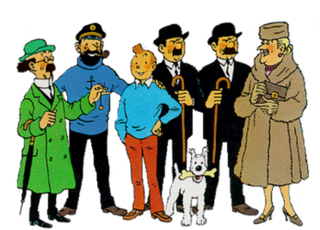
The Adventures of Tintin is a series of 24 comic albums created by Belgian cartoonist Georges Remi, who wrote under the pen name Hergé. The series was one of the most popular European comics of the 20th century. By 2007, a century after Hergé's birth in 1907, Tintin had been published in more than 70 languages with sales of more than 200 million copies, and had been adapted for radio, television, theatre, and film.

The Red Sea Sharks is the nineteenth volume of The Adventures of Tintin, the comic series by Belgian cartoonist Hergé. The story was initially serialised weekly in Belgium's Tintin magazine from October 1956 to January 1958 before being published in a collected volume by Casterman in 1958. The narrative follows the young reporter Tintin, his dog Snowy, and his friend Captain Haddock as they travel to the fictional Middle Eastern kingdom of Khemed with the intention of aiding the Emir Ben Kalish Ezab in regaining control after a coup d'état by his enemies, who are financed by slave traders led by Tintin's old nemesis Rastapopoulos.

Bianca Castafiore, nicknamed the "Milanese Nightingale", is a fictional character in The Adventures of Tintin, the comics series by Belgian cartoonist Hergé. She is an opera singer who frequently pops up in adventure after adventure. While famous and revered the world over, most of the main characters find her voice shrill and appallingly loud, most notably Captain Haddock, who ironically is the object of Castafiore's affections. She also has a habit of mispronouncing everyone's names, with the exception of Tintin and her personal assistants. Castafiore is comically portrayed as narcissistic, whimsical, absent-minded, and talkative, but often shows a more generous and essentially amiable side, in addition to an iron will.

The Castafiore Emerald is the twenty-first volume of The Adventures of Tintin, the comics series by Belgian cartoonist Hergé. It was serialised weekly from July 1961 to September 1962 in Tintin magazine. In contrast to the previous Tintin books, Hergé deliberately broke the adventure formula he had created: it is the only book in the series where the characters remain at Marlinspike Hall, Captain Haddock's family estate, and neither travel abroad nor confront dangerous criminals. The plot concerns the visit of the opera singer Bianca Castafiore and the subsequent theft of her emerald.

Flight 714 to Sydney is the twenty-second volume of The Adventures of Tintin, the comics series by Belgian cartoonist Hergé. It was serialised weekly from September 1966 to November 1967 in Tintin magazine. The title refers to a flight that Tintin and his friends fail to catch, as they become embroiled in their arch-nemesis Rastapopoulos' plot to kidnap an eccentric millionaire from a supersonic business jet on a Sondonesian island.
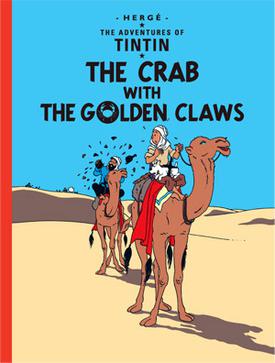
The Crab with the Golden Claws is the ninth volume of The Adventures of Tintin, the comics series by Belgian cartoonist Hergé. The story was serialised weekly in Le Soir Jeunesse, the children's supplement to Le Soir, Belgium's leading francophone newspaper, from October 1940 to October 1941 amidst the German occupation of Belgium during World War II. Partway through serialisation, Le Soir Jeunesse was cancelled and the story began to be serialised daily in the pages of Le Soir. The story tells of young Belgian reporter Tintin and his dog Snowy, who travel to Morocco to pursue the international opium smugglers. The story marks the first appearance of main character Captain Haddock.

Tintin in Tibet is the twentieth volume of The Adventures of Tintin, the comics series by Belgian cartoonist Hergé. It was serialised weekly from September 1958 to November 1959 in Tintin magazine and published as a book in 1960. Hergé considered it his favourite Tintin adventure and an emotional effort, as he created it while suffering from traumatic nightmares and a personal conflict while deciding to leave his wife of three decades for a younger woman. The story tells of the young reporter Tintin in search of his friend Chang Chong-Chen, who the authorities claim has died in a plane crash in the Himalayas. Convinced that Chang has survived and accompanied only by Snowy, Captain Haddock and the Sherpa guide Tharkey, Tintin crosses the Himalayas to the plateau of Tibet, along the way encountering the mysterious Yeti.

The Secret of the Unicorn is the eleventh volume of The Adventures of Tintin, the comics series by Belgian cartoonist Hergé. The story was serialised daily in Le Soir, Belgium's leading francophone newspaper, from June 1942 to January 1943 amidst the Nazi German occupation of Belgium during World War II. The story revolves around young reporter Tintin, his dog Snowy, and his friend Captain Haddock, who discover a riddle left by Haddock's ancestor, the 17th century Sir Francis Haddock, which can lead them to the hidden treasure of the pirate Red Rackham. To unravel the riddle, Tintin and Haddock must obtain three identical models of Sir Francis's ship, the Unicorn, but they discover that criminals are also after three model ships and are willing to kill in order to obtain them.

Red Rackham's Treasure is the twelfth volume of The Adventures of Tintin, the comics series by Belgian cartoonist Hergé. The story was serialised daily in Le Soir, Belgium's leading francophone newspaper, from February to September 1943 amidst the German occupation of Belgium during World War II. Completing an arc begun in The Secret of the Unicorn, the story tells of young reporter Tintin and his friend Captain Haddock as they launch an expedition to the Caribbean to locate the treasure of the pirate Red Rackham.
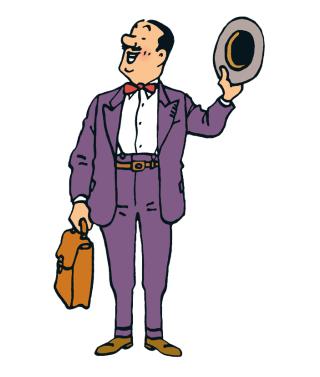
Jolyon Wagg is a fictional character in The Adventures of Tintin, the comics series by Belgian cartoonist Hergé. He is a gregarious, simple, and overbearing man who enters the story by barging in uninvited.

Tintin and the Picaros is the twenty-third volume of The Adventures of Tintin, the comics series by Belgian cartoonist Hergé. The final instalment in the series to be completed by Hergé, it was serialized in Tintin magazine from September 1975 to April 1976 before being published in a collected volume by Casterman in 1976. The narrative follows the young reporter Tintin, his dog Snowy and his friends Captain Haddock and Professor Calculus as they travel to the (fictional) South American nation of San Theodoros to rescue their friend Bianca Castafiore, who has been imprisoned by the government of General Tapioca. Once there, they become involved in the anti-government revolutionary activities of Tintin's old friend General Alcazar.

The Seven Crystal Balls is the thirteenth volume of The Adventures of Tintin, the comics series by Belgian cartoonist Hergé. The story was serialised daily in Le Soir, Belgium's leading francophone newspaper, from December 1943 amidst the German occupation of Belgium during World War II. The story was cancelled abruptly following the Allied liberation in September 1944, when Hergé was blacklisted after being accused of collaborating with the occupying Germans. After he was cleared two years later, the story and its follow-up Prisoners of the Sun were then serialised weekly in the new Tintin magazine from September 1946 to April 1948. The story revolves around the investigations of a young reporter Tintin and his friend Captain Haddock into the abduction of their friend Professor Calculus and its connection to a mysterious illness which has afflicted the members of an archaeological expedition to Peru.

Land of Black Gold is the fifteenth volume of The Adventures of Tintin, the comics series by Belgian cartoonist Hergé. The story was commissioned by the conservative Belgian newspaper Le Vingtième Siècle for its children's supplement Le Petit Vingtième, in which it was initially serialised from September 1939 until the German invasion of Belgium in May 1940, at which the newspaper was shut down and the story interrupted. After eight years, Hergé returned to Land of Black Gold, completing its serialisation in Belgium's Tintin magazine from September 1948 to February 1950, after which it was published in a collected volume by Casterman in 1950. Set on the eve of a European war, the plot revolves around the attempts of young Belgian reporter Tintin to uncover a militant group responsible for sabotaging oil supplies in the Middle East.
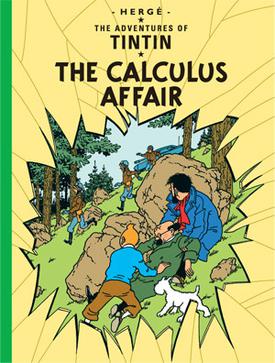
The Calculus Affair is the eighteenth volume of The Adventures of Tintin, the comics series by the Belgian cartoonist Hergé. It was serialised weekly in Belgium's Tintin magazine from December 1954 to February 1956 before being published in a single volume by Casterman in 1956. The story follows the attempts of the young reporter Tintin, his dog Snowy, and his friend Captain Haddock to rescue their friend Professor Calculus, who has developed a machine capable of destroying objects with sound waves, from kidnapping attempts by the competing European countries of Borduria and Syldavia.
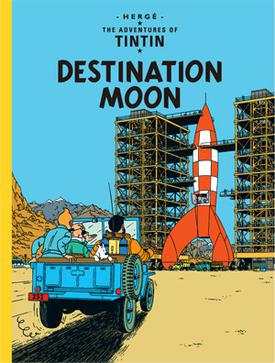
Destination Moon is the sixteenth volume of The Adventures of Tintin, the comics series by Belgian cartoonist Hergé. The story was initially serialised weekly in Belgium's Tintin magazine from March to September 1950 and April to October 1952 before being published in a collected volume by Casterman in 1953. The plot tells of young reporter Tintin and his friend Captain Haddock who receive an invitation from Professor Calculus to come to Syldavia, where Calculus is working on a top-secret project in a secure government facility to plan a crewed mission to the Moon.
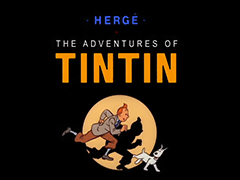
The Adventures of Tintin is an animated television series co-produced and animated by French animation studio Ellipse Programme and Canadian studio Nelvana Limited. The series is based on the comic book series of the same name by Belgian cartoonist Hergé. 39 half-hour episodes were produced over the course of three seasons, originally airing in France, Canada, and the United States between 1991 and 1992.

Abdullah is a fictional character from The Adventures of Tintin, created by Hergé. He first appeared in 1949 in the second version of Tintin in the Land of Black Gold. Aged 6 at the time of his first appearance, he is the son of Mohammed Ben Kalish Ezab, the Emir of Khemed, a fictional state on the Arabian Peninsula. The character of Abdullah is physically inspired by Faisal II, who acceded to the throne of Iraq in 1939, at the age of 3.

















